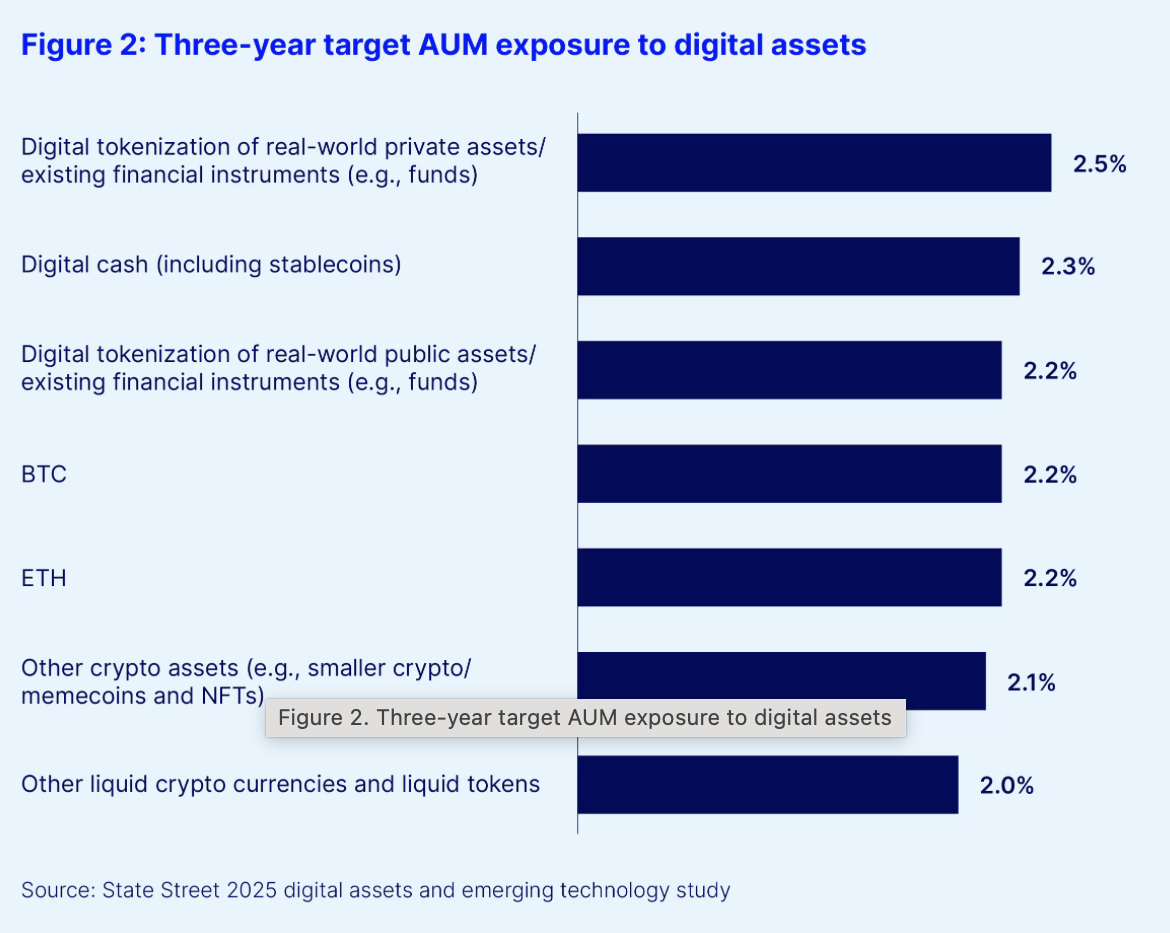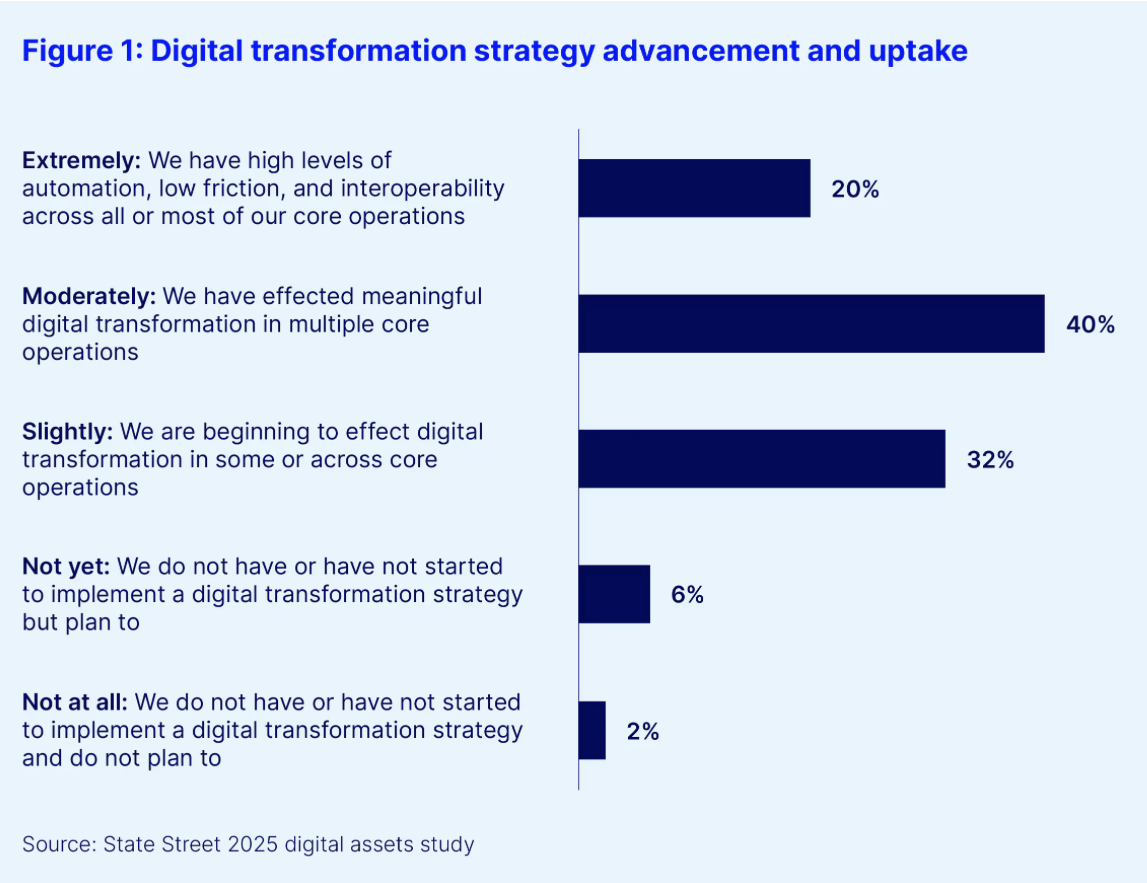Institutional digital assets exposure is rising: a new State Street survey finds institutions currently hold about 7% in digital assets and expect this to reach 16% by 2028, led by stablecoins and tokenized equities, while many remain cautious about full DeFi-TradFi convergence.
-
7% current allocation; projected 16% by 2028
-
Holdings are concentrated in stablecoins and tokenized listed assets; private assets seen as first to benefit from tokenization.
-
Bitcoin and Ethereum led performance: 27% and 21% of respondents respectively cited these as top returns.
Institutional digital assets: State Street finds 7% current allocation and 16% expected by 2028 — read implications for blockchain, AI and tokenization.
Institutional investors are deepening exposure to blockchain and generative AI while allocating more capital to digital assets, though many expect a hybrid DeFi–TradFi future rather than full onchain migration.
What are institutional digital assets and how fast are allocations growing?
Institutional digital assets are tokenized or blockchain-native instruments such as stablecoins, tokenized equities and cryptocurrencies. According to a State Street survey, institutions currently allocate about 7% of portfolios to these assets and expect allocations to rise to roughly 16% by 2028.
Most institutional holdings today favor digital cash (stablecoins) and tokenized versions of listed equities or fixed income. Asset managers report slightly higher exposure than other institutional types.

Source: State Street
How did cryptocurrencies perform in the survey results?
Despite stablecoins and tokenized assets forming the majority of holdings, respondents identified cryptocurrencies as the strongest performers. Bitcoin was cited by 27% as the best-performing asset, followed by Ethereum at 21%.
These performance signals are increasing institutional interest in liquid crypto exposures alongside tokenization strategies for private and public market assets.
Why are institutions pairing blockchain with generative AI?
Institutions view distributed ledger technology and generative AI as complementary tools for digital transformation. The State Street study found that 29% of respondents regard blockchain as integral to transformation plans and about 45% believe generative AI will accelerate digital asset development.

Source: State Street
Respondents highlighted practical blockchain uses beyond trading: cash flow management (61%), business data processes (60%), and legal/compliance functions (31%). Generative AI is expected to speed smart contract and token development, reducing time and cost.
How will DeFi and TradFi interact in the coming years?
Survey respondents are split on whether blockchain will replace traditional infrastructure. Nearly half (43%) now expect hybrid DeFi–TradFi operations to be mainstream within five years, up sharply from 11% a year ago.
Conversely, 14% said they do not expect digital systems to ever fully replace traditional trading and custody, a rise from 3% in 2024. Most institutions foresee a gradual, hybrid transition rather than immediate full migration.
Plain text related items: Bitcoin miners and AI firms compete for cheap sustainable energy. AI-generated content needs blockchain before trust in digital media collapses. Thailand’s ‘Big Secret’ crypto hack, Chinese developer’s RWA tokens: Asia Express.
Frequently Asked Questions
How much of institutional portfolios are digital or tokenized assets expected to be by 2030?
Just over half (52%) of surveyed institutions expect 10–24% of investments by 2030 to be made through digital or tokenized instruments; only 1% anticipate most investments will be entirely onchain.
What asset classes are institutions tokenizing first?
Private assets are seen as the top candidate to benefit first from tokenization, with tokenized listed equities and fixed income also receiving meaningful early allocations for liquidity and fractionalization benefits.
Key Takeaways
- Growing allocations: Institutions report 7% current allocation to digital assets, projected to reach 16% by 2028.
- Stablecoins & tokenization: Stablecoins and tokenized securities dominate holdings, while crypto delivers the strongest returns.
- Hybrid future: Most expect a hybrid DeFi–TradFi model; full replacement of TradFi is widely viewed as unlikely in the near term.
Conclusion
This State Street-backed survey shows institutional digital assets are moving from experiment to allocation, with blockchain and generative AI central to transformation strategies. Institutions appear to favor tokenization and hybrid models, signaling steady but cautious adoption — monitor allocation trends and regulatory developments as tokenization scales.
Published: 2025-10-10 • Updated: 2025-10-10 • Author: COINOTAG
